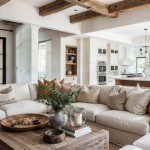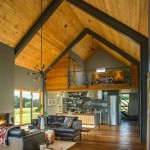Coastal Living Decorating Ideas: Bringing the Ocean Home
Coastal living decor evokes a sense of tranquility, relaxation, and connection to nature. It borrows inspiration from the seaside environment, incorporating elements that remind one of the beach, the ocean, and the overall coastal atmosphere. This style is characterized by its light and airy feel, use of natural materials, and a color palette that reflects the hues of the sea and sand. Successfully implementing coastal decor involves thoughtful consideration of color, texture, furniture, and accessories.
Embracing the Coastal Color Palette
The color scheme is paramount in achieving a coastal aesthetic. The primary colors typically associated with this style are various shades of blue, ranging from light sky blue to deep navy. These represent the different facets of the ocean and sky. White is another essential color, often utilized as a base to create a bright and airy canvas. It mirrors the white sand and sun-bleached surfaces found along the coast. Neutrals like beige, sand, and light gray are also integrated to provide a grounding effect and mimic the colors of dunes and driftwood. Accents of coral, seafoam green, or pale yellow can be used sparingly to add pops of color and visual interest, referencing seashells and other natural elements.
When choosing paint colors, consider the natural light in the space. Rooms with ample sunlight can handle cooler blue tones, while darker rooms may benefit from warmer, more muted shades. It's also important to consider the undertones of other elements in the room, such as flooring and furniture, to ensure a cohesive and harmonious look. Utilizing paint chips and testing colors in different lighting conditions is crucial for accurate representation.
Beyond paint, the color palette extends to textiles and accessories. Upholstery fabrics, curtains, and rugs should reflect the coastal color scheme. Linen, cotton, and other natural fibers are excellent choices. Patterns can also play a role, with subtle stripes, nautical motifs, and abstract representations of waves or coral adding visual texture. However, it's generally best to avoid overly busy or vibrant patterns, as they can detract from the overall calming effect of the coastal style.
The distribution of color is also important. White or light neutrals are typically used for walls and large furniture pieces, while blues and other accent colors are incorporated through smaller items like throw pillows, artwork, and decorative objects. This helps to create a balanced and visually appealing space.
Incorporating Natural Materials and Textures
A defining characteristic of coastal decor is the incorporation of natural materials and textures. These elements contribute to the organic and relaxed feel of the style, connecting the interior space to the natural environment. Wood, in its various forms, is a staple material. Whitewashed or distressed wood furniture, such as tables, chairs, and dressers, adds a rustic and weathered touch, reminiscent of driftwood that has been shaped by the ocean. Bamboo and rattan are also popular choices for furniture, lighting fixtures, and decorative accents. These materials are lightweight, durable, and have a natural warmth that complements the coastal aesthetic.
Natural fibers, such as jute, seagrass, and sisal, are commonly used for rugs and floor coverings. These materials provide a durable and textured surface underfoot, while also adding a touch of organic warmth to the space. They are often woven in neutral colors, allowing them to blend seamlessly with the overall color scheme. Linen and cotton are preferred textiles for upholstery, curtains, and bedding. These fabrics are breathable, comfortable, and have a relaxed drape that contributes to the casual feel of the style. Canvas is another durable and versatile material that can be used for upholstery, wall art, or even as a room divider.
Seashells, coral, and other natural elements can be used as decorative accents. These items can be displayed in glass jars, arranged on shelves, or incorporated into artwork. However, it's important to use these elements sparingly and tastefully, avoiding clutter and maintaining a sense of simplicity. Driftwood can also be used to create unique and eye-catching decorative pieces, such as sculptures, picture frames, or even lighting fixtures.
Stone and glass are also incorporated into coastal decor. Stone countertops, floors, or fireplaces can add a touch of natural elegance to the space. Glass elements, such as vases, bowls, and lamps, reflect light and create a sense of airiness. Clear glass is often preferred, as it allows natural light to pass through unobstructed.
Selecting Coastal-Inspired Furniture and Accessories
Furniture selection is crucial in establishing the overall mood and functionality of a coastal-themed space. The emphasis is on comfort, practicality, and a relaxed aesthetic. Upholstered furniture, such as sofas and armchairs, should be comfortable and inviting, with cushions made from natural materials like linen or cotton. Slipcovered furniture is a practical choice, as it is easy to clean and maintain, making it ideal for a casual coastal home. Wicker or rattan furniture can be used to create a relaxed and informal seating area, either indoors or outdoors.
Coffee tables and side tables should be functional and stylish, with options ranging from reclaimed wood designs to glass-topped tables that showcase seashells or other coastal elements underneath. Shelving units can be used to display books, decorative objects, and plants, adding visual interest and personality to the space. Opt for open shelving to maintain a light and airy feel. Mirrors are also valuable additions, as they reflect light and create the illusion of more space.
Accessories play a vital role in completing the coastal look. Nautical-themed artwork, such as seascapes, sailboat paintings, or maps, can add a touch of maritime charm to the walls. Shells, starfish, and coral can be used as decorative accents, but should be used sparingly to avoid clutter. Coastal-themed throw pillows, with patterns featuring stripes, anchors, or seashells, can add a pop of color and personality to sofas and armchairs. Throw blankets made from natural fibers, such as cotton or linen, provide warmth and comfort, while also adding texture to the space.
Lighting is also an important consideration. Natural light should be maximized by using sheer curtains or blinds that allow sunlight to filter through. Table lamps and floor lamps with coastal-inspired designs, such as those featuring driftwood bases or linen shades, can provide ambient lighting in the evenings. Pendant lights or chandeliers with nautical themes can be used to create a focal point in the dining area or living room. Candles and lanterns can also be used to create a warm and inviting atmosphere.
Window treatments should be chosen to complement the overall coastal aesthetic. Sheer curtains or blinds made from natural materials, such as linen or bamboo, are ideal for allowing natural light to filter through while providing privacy. Heavier curtains can be used in bedrooms to block out light and create a more restful atmosphere. Avoid overly ornate or formal window treatments, as they can detract from the casual and relaxed feel of the coastal style.
Outdoor spaces should also be considered when decorating in a coastal style. Outdoor furniture made from weather-resistant materials, such as teak or wicker, can create a comfortable and inviting seating area on a patio or deck. Outdoor rugs made from durable materials, such as polypropylene, can add color and texture to the space. Plants that thrive in coastal environments, such as succulents, grasses, and palm trees, can add a touch of greenery and create a relaxing outdoor oasis. Lighting fixtures, such as string lights or lanterns, can create a warm and inviting atmosphere in the evenings.
It is important to remember that coastal decor is not about rigidly adhering to a specific set of rules, but rather about creating a space that evokes a sense of peace, tranquility, and connection to the sea. Personalizing the space with unique pieces and incorporating elements that reflect individual preferences will ultimately result in a coastal home that is both stylish and comfortable.

Coastal Living Room Ideas

Coastal Living Room Ideas
Coastal Living Room Ideas And Designs Renoguide N Renovation Inspiration

250 Coastal Living Rooms Decor Design Ideas In 2025 Room

30 Coastal Living Room Design Ideas By Designer Rooms

17 Neutral Coastal Living Room Designs Decor Ideas

Coastal Living Room Ideas

7 Coastal Living Room Ideas For Summer The Lakeside Collection

Beautiful Living Room Decorating Ideas For 2025 Jane At Home Modern Coastal Design Inspiration

Modern Coastal Themed Living Room Decor Design Ideas







